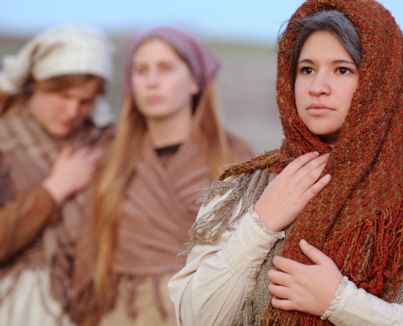|
Opera
OPERA GEMS IN COZY SEBASTOPOL THEATER
by Pamela Hicks Gailey
Friday, February 9, 2024
Opera
CINNABAR HITS IT OUT OF THE PARK WITH A GRAND TOSCA
by Pamela Hicks Gailey
Sunday, June 18, 2023
Opera
SANTA ROSA'S MAJESTICAL MAGIC FLUTE IN WEILL
by Pamela Hicks Gailey
Saturday, April 15, 2023
Opera
MARIN'S STRIPPED-DOWN OPERA CHARMS
by Abby Wasserman
Sunday, July 17, 2022
Opera
SONOROUS WAGNER GALA AND CAPACITY CROWD AT VALLEJO'S EMPRESS
by Pamela Hicks Gailey
Saturday, July 9, 2022
Opera
VERDI'S THEATRICAL LA TRAVIATA TRIUMPHS AT CINNABAR
by Terry McNeill
Sunday, June 19, 2022
Opera
DONIZETTI'S DON PASQUALE HAS LYRICAL CHARM IN MENDOCINO FESTIVAL PRODUCTION
by Elly Lichenstein
Friday, July 14, 2017
Opera
ONE-NIGHT STAND AT MMF'S ABDUCTION FROM THE SERAGLIO
by Terry McNeill
Friday, July 15, 2016
Opera
FROTHY FROLICKING AT CINNABAR'S MAGICAL FLUTE
by Terry McNeill
Saturday, June 11, 2016
Opera
OPERA BUFFA HI JINX IN ROSSINI'S BARBER AT MENDO FESTIVAL
by Ken Bullock
Friday, July 17, 2015
|
 |
 Sara Sims, Canela McCoubrey and Talia Trozzo in Riders to the Sea (L. Mullins photo) |
OPERATIC TWIN BILL OPENS AT SONOMA STATE
by Terry McNeill
Thursday, February 7, 2013
Two one-act operas--Haydn's "The Deserted Island" and Vaughan Williams' "Riders to the Sea"--currently being mounted by Sonoma State University's music, theater and dance departments, reflect the University's usual innovative staging and production. On the Feb. 7 opening night Person Theater's 400 seats were two-thirds filled, overwhelmingly by students. Both operas were in English and had supertitles. Is this common for our common language?
Haydn is known mainly today through his masterful symphonies, quartets and perhaps the keyboard sonatas. He wrote at least 14 operas, however, including the 1779 buff opera the buffa "l'Isola Disabitata," performed here in translation as "The Deserted Island." Conductor Lynne Morrow crafted a one 55-minute act from the original two-act version, and led a sprightly overture that with just 12 instruments resounded from the pit into the hall. The cello and bass parts (Laura McClellan and Steven Hoffman) carried well out of the pit, as did Ruth Wilson's horn playing.
Sonic problems began quickly with the appearance of sopranos Kathryn Foster and Kathleen Barnes, as the individual microphones gave an irritating electronic echo at the end of any sound above a mezzo forte. This was ultimately corrected and the singers settled down to performing the silly plot of separated spouses reuniting, and strangers about to be united, on the island of the title.
Peter Crompton's set design had low platform and large rock (the latter fits into the action as a carving stone) backed by a 20-foot round moon, with colors constantly changing. Now much happens with stage direction in this frothy opera, the scenes directed by Danielle Cain, and each vignette melds into the previous one. There is a lot of recitative and some witless stage walking as boys search for girls, and ultimately at least one girl searches for a boy.
Nonetheless, the bouncy Haydn score and deft singing were engaging. Ted Smith's Gernando, the character beached to find a lost mate, was resonantly sung, as was Ms. Barnes' Silvia with a secure top to her voice. Tenor Max Jennings (Enrico) has a small voice and not an especially colorful one for the part, but was careful to never upstage Mr. Smith as he courted the fetching Ms. Barnes, a novice in the ways of men and love.
The audience response to the final chords was raucous and clearly many of the loudest cheers came from friends of the cast. Ms. Morrow received a separate ovation.
Following intermission Vaughan Williams' 45-minute opera "Riders to the Sea" dampened any lingering Haydn frivolity. The set of this somber 1937 work depicted a seaside home of barren timbers, tattered fish netting drapes and stark Irish furniture. Material colors were drab and quickly set a depressive mood. The backdrop of the Deserted Island's first half moon had evolved into a changeable seascape, augmented by adroit lighting by designer Theo Bridant.
The cast was uniformly excellent, especially Sarah Sims' compelling singing of the daughter Nora's role and Talia Trozzo's woeful portrayal of the tragedy-struck family matriarch Maurye. In the early sections of the opera the composer introduces an ascending short leitmotif that precedes many of the short recitatives, and reflects the crushing series of deaths at sea that has been the family's fate. The piano, played by Yvonne Wormer, and Julia Harrell's percussion performance were stellar parts of the evocative sound Ms. Morrow's clear beat drew from the orchestra.
Seemingly innocuous events in this drama impacted the psychology of the singers, from Ms. Sims and Canela Fullbright McCoubrey folding laundry while speaking of their dead brother, to the penetrating look Ms. Trozzo gave to her last son Bartley, departing for his ride to the sea and his demise. A nine-woman chorus, swathed in heavy red cloaks that made them appear almost as apparitions, added to the vocal fabric in melisma. The play of ethereal orchestral sound, the lamenting chorus, Daniel Celidore's mournful oboe solo and Ms. Trozzo's palpable anguish were powerfully present over the last section of the opera. The wash of the sea, through the auditorium's speakers, was a benediction.
The ovation that followed, students recognizing cast members and being moved by the dark tableau, was loud and perhaps slightly incongruous given the stark drama they had just witnessed.
Additional production dates and times are listed in the Calendar tab at www.classicalsonoma.org, including a Feb. 13 matinee performance
|

